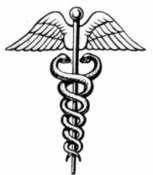The humble snake or serpent carries a lot of symbolic weight in this world of ours. In the west, serpents have taken on an extremely negative connotation from their association with the forces of evil, courtesy of the story of Genesis (3:1-5 - this is from the
KJV):
Now the serpent was more subtil than any beast of the field which the LORD God had made. And he said unto the woman, Yea, hath God said, Ye shall not eat of every tree of the garden?
And the woman said unto the serpent, We may eat of the fruit of the trees of the garden:
But of the fruit of the tree which is in the midst of the garden, God hath said, Ye shall not eat of it, neither shall ye touch it, lest ye die.
And the serpent said unto the woman, Ye shall not surely die:
For God doth know that in the day ye eat thereof, then your eyes shall be opened, and ye shall be as gods*, knowing good and evil.
This first demonstration of the potency of humanity's free will is, of course, an incredible disaster. Adam and Eve get booted from the Garden; by some accounts they enter into the world of pain and mortality; they are forever separated from the earthly paradise.
Sometimes the serpent of Genesis is depicted as a literal snake in western art:
I prefer the Medieval and Renaissance tradition of depicting him as a weird sort of snake with human parts:
In Eastern traditions, the serpent takes on an entirely other set of meanings. Yogis trained their bodies and minds in order to awaken Kundalini, a powerful spiritual energy that sits coiled at the base of the spine, and is dormant in most people. Once awakened, Kundalini enables the practitioner to unite his or her consciousness with the Universal consciousness, or Shiva.
The Western remnant of the knowledge of Kundalini is in the medical symbol of the Caduceus, a pair of intertwined snakes wrapped around a central post, with a pair of wings at the top.
My tai chi teacher says that the two serpents represent the twin energies of the physical and the emotional. United together and harmonized, these two energies support spiritual endeavours and the spiritual aspect of our being. Each place where the Caduceus intertwines, including the place where the heads face each other, marks the location of a major chakra point, from the root to the crown.
In western alchemy and occult practices, the Caduceus was the symbol of the illuminated individual who had managed to elevate himself to the level of godhood through his practices. In such images, eastern and western practices mirror each other, revealing that this alternative view of the serpent persisted despite the negative associations of Genesis.
* (For the Buffy fans)








Very cool, yet again. :)
ReplyDeleteVery interesting post. I hadn't heard about the connection between the Caduceus and the Chakras before - very cool indeed.
ReplyDeleteThanks, L.G.!
ReplyDeleteI thought you would like that one, Laurie. You should check out my post on Lulu Hurst, too, if you haven't had the chance. It's pretty interesting for anyone who is interested in chi.